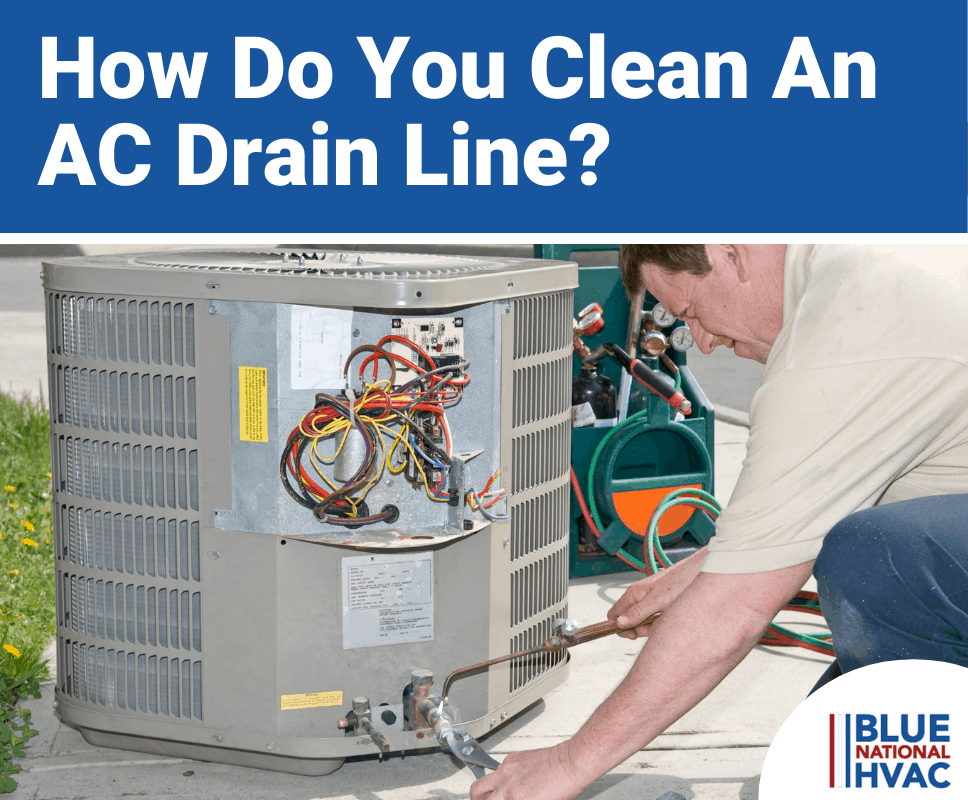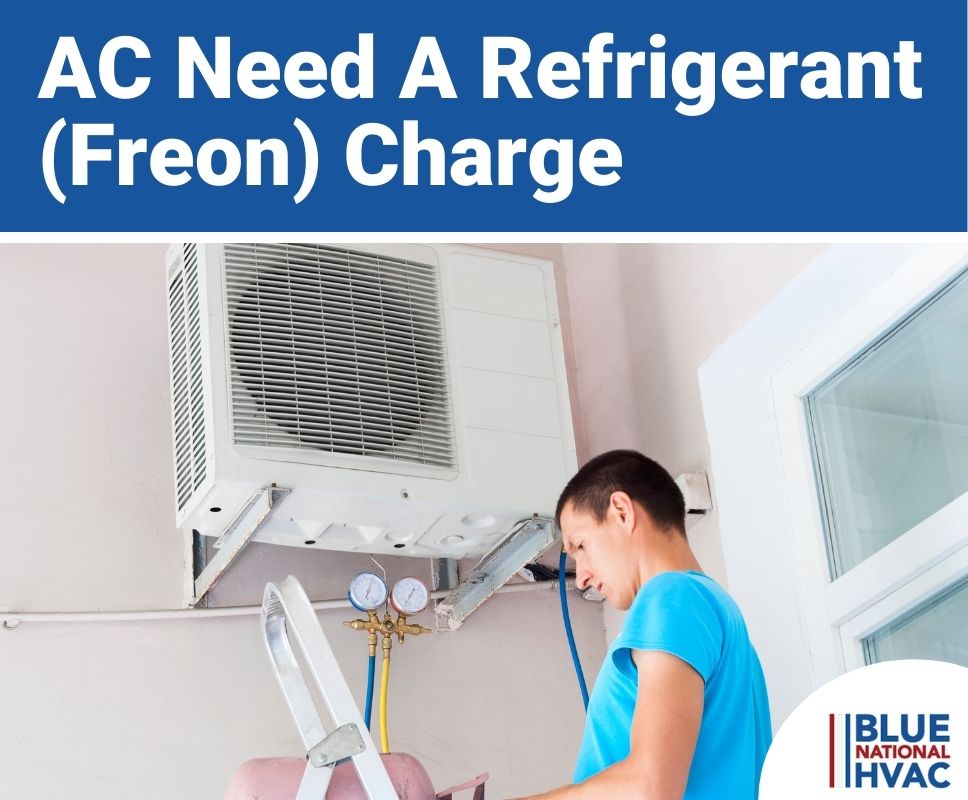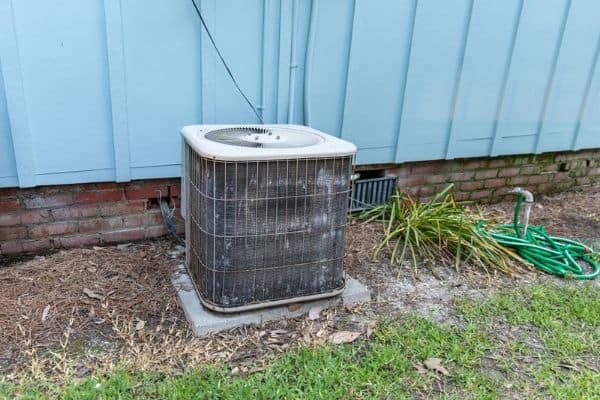And much more!
So, if you’re looking for how to clean your drain line, keep reading our detailed guide below to get answers to all of your questions!
What Is An AC Drain Line?
An AC condensate drain line is the path taken by the water that builds up in the condensate drain pan of your air conditioning unit.
It’s entirely normal for water to build up in the drain pan. Condensation is actually humidity that is removed from the air as your evaporator coil cools it!
As the humidity from the air condenses into water, it is collected in the condensate drain pan. The drain pan connects to the condensate drain line (AC drain line) that is angled to flow, by gravity, through the pipe to its exit outside your home.
AC Drain Line Location
Most homes have the inside portion of their air conditioning system (the air handler) installed in their attic, basement, or garage. The condensate drain line is a white PVC pipe that connects to the air handler.
If the air handler is installed in your basement or garage, the condensate drain line may feed directly into a floor drain or a sump pit.
Homeowners with an air handler and condenser unit installed in their attic will want to be especially mindful of keeping their AC drain line clear.
The drain line runs all the way from your attic and exits outside your house, usually a couple of feet above the ground.
If it gets clogged, the condensate pan can overflow water in your attic and cause water damage to your ceiling.
Preventing damage is the most crucial reason to do routine maintenance on your drain line. It prevents further damage to your air conditioning system.
What Do You Need To Know About Air Conditioning Drain Lines?
Cleaning your AC condensate drain shouldn’t only be done when you notice an issue, it’s something that you should do regularly (or hire a pro to do) in order to keep it clear and maintain your AC unit.
How Does the Condensate Drain Line Get Clogged?
You might be wondering how your drain line could get clogged in the first place – it’s just water, right?
Well, no. The drain line can actually get clogged with algae, microbes, rust, mildew, and even dust that’s in the air. Over time, all of these small particulates can build up into a sticky mess that blocks the condensate drain pipe’s flow.
How Can You Tell if the AC Drain Line has a Clog?
Most homeowners realize there’s a problem when water starts leaking from their air handler.
Either they notice water dripping through their ceiling (if they have an attic unit) or a puddle of water may show up under units that are installed in a garage or basement.
If you don’t see the drain line dripping water when the AC unit is running, that is a sure-fire way to diagnose clogging. Water should not be rushing out of the drainpipe. It should be a slow drip.
What Are The Different Ways to Fix a Condensate Drain Line?
There are a few ways to unclog a condensate drain line. It is not a super complex process and could be a quick DIY process. However, if you’re not comfortable doing it, you can hire one of our professional HVAC technicians to do it for you.
Before you attempt to fix the drain line or clean it, turn off your HVAC system first. Don’t just turn it off with the thermostat – cut the power with your breaker box.
If you determine you have a clogged AC drain line, you can pull out your shop vacuum for a quick fix! Don’t use your regular dry vacuum to vacuum your drain line – make sure the vacuum you use is rated for vacuuming up water.
Once you have your shop vac in hand, head to your condensate line and put the hose of your vacuum over the outlet of the condensate drain line.
The vacuum hose is likely a few inches wider than the drain line, so you’ll want to wrap a towel around the gap to seal it. You can also seal it with duct tape.
Once you have the vacuum hose sealed over the drainpipe, turn on the shop vac and let it run for 3-5 minutes. While it is on, it will suck out a bunch of water and perhaps even the clog itself!
After you remove the vacuum hose from the drain line, you may see water gush out of the drain line. Water flowing out is an indication the clog may be cleared.
However, vacuuming the drain line might only be a temporary solution. It might have only partially cleared the clog or removed one of many clogs. You might also want to run vinegar through the line or clean it with a pipe cleaner too.
Pipe Cleaner
You can use a stiff, narrow wire brush or pipe cleaner to remove the blockage. You can force it into the end of the AC drain line.
The brush will only remove clogs close to the end of the pipe. Most of the time, clogs are closer to the condenser, so you might have more work.
Where your condensate drain line connects to your condenser, there is usually a vent tee. You can remove the cap on the tee and use a drain snake here. A drain snake has upward-facing hooks that might be able to grab the clog and pull it out.
Please note, if you’re not comfortable doing this type of work and you’re a complete novice with this, it’s best to hire one of our professionals to assess the situation and get it solved correctly.
Warm Water
You can pour warm water down the vent tee of your condensate drain line or into the condensate daring line to force the clog out too. If it’s not a tight clog, the hot water might be enough to force it loose.
Bleach
You can also pour a mixture of 1:1 ratio of bleach to water down the drain line to clear it. The corrosive bleach will also remove any algae that could be growing in the pipe.
Usually, a 2 cup mixture is enough. After pouring into the vent tee – wait 30-60 minutes and see if it comes out of the exit of the drain line.
Please just be aware that bleach can be dangerous to work with and this method might be better left to one of our professionals.
Vinegar
If you’re not a fan of bleach, you can use a distilled vinegar and water mix instead. Vinegar is also a bit corrosive and will disable algae too while removing the clog.
You can use a cup of vinegar to a cup of water and follow the same steps as using bleach to clean your AC drain line. White vinegar works just as well too.
Use a Garden Hose to Flush the Drain Line
If you have a long enough garden hose to run from your garden facet to the beginning of your condensate drain line, you can try to force the blockage out with it.
After you run the garden hose through your house to the drain line, turn the water on all the way and let it run. Keep an eye on it to make sure it doesn’t overflow. Most of the time, the pressure from the extra water is enough to dislodge the clog.
When Should You Hire A Professional To Fix Your Condensate Drain Line?
You should hire one of our AC specialists or HVAC technicians to clean your condensate drain line if you are uncomfortable doing any of the above steps.
If your air handler that contains the condensate drain pan is in your attic, you might not be physically able to climb up there. In that case, you should hire one of our seasoned professionals who can make quick work of it.









